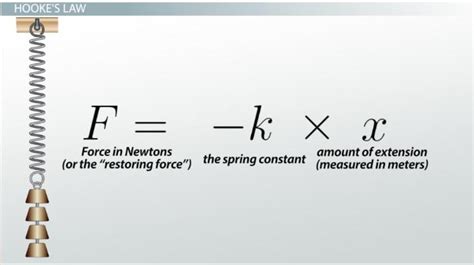Formula For A Spring

The concept of a spring is often associated with the idea of renewal and rejuvenation, as seen in the cyclical pattern of the seasons. However, in the context of physics and engineering, a spring refers to an elastic object that stores energy when it is compressed or stretched. The behavior of a spring can be described using a simple formula, known as Hooke’s Law, which states that the force exerted by a spring is proportional to its displacement from its equilibrium position.
Mathematically, Hooke’s Law can be expressed as F = kx, where F is the force exerted by the spring, k is the spring constant, and x is the displacement of the spring from its equilibrium position. The spring constant, k, is a measure of the stiffness of the spring, and it depends on the material properties and geometry of the spring. For example, a spring with a high spring constant will exert a greater force when displaced by a given amount, while a spring with a low spring constant will exert a smaller force.
To illustrate this concept, consider a simple example. Suppose we have a spring with a spring constant of 10 N/m, and we compress it by 0.5 m. Using Hooke’s Law, we can calculate the force exerted by the spring as F = kx = 10 N/m x 0.5 m = 5 N. This means that the spring will exert a force of 5 N when compressed by 0.5 m.
In addition to Hooke’s Law, there are other formulas that can be used to describe the behavior of springs. For example, the energy stored in a spring can be calculated using the formula U = 0.5kx^2, where U is the energy, k is the spring constant, and x is the displacement. This formula can be used to determine the amount of energy stored in a spring when it is compressed or stretched.
To further explore the concept of springs, let’s consider a few examples of how they are used in real-world applications. One common use of springs is in shock absorption systems, such as those used in vehicles and machinery. In these systems, springs are used to absorb and dissipate energy, reducing the impact of shocks and vibrations.
Calculating the Energy Stored in a Spring
- Determine the spring constant, k, and the displacement, x, of the spring.
- Use the formula U = 0.5kx^2 to calculate the energy stored in the spring.
- Plug in the values of k and x to obtain the energy, U.
Another example of the use of springs is in mechanical watches and clocks. In these devices, springs are used to store energy, which is then released to power the movement of the watch or clock. The use of springs in timekeeping devices has a long history, dating back to the 15th century.
Advantages and Disadvantages of Using Springs
| Advantages | Disadvantages |
|---|---|
| High energy storage capacity | Can be prone to fatigue and failure |
| Low maintenance requirements | Can be sensitive to temperature changes |
| Wide range of applications | Can be expensive to manufacture |

In conclusion, the formula for a spring is a fundamental principle in physics and engineering, and it has numerous applications in fields such as mechanics, materials science, and civil engineering. By understanding the behavior of springs and how they can be used to store and release energy, we can design and develop innovative solutions to real-world problems.
What is Hooke’s Law?
+Hooke’s Law is a fundamental principle in physics and engineering that states that the force exerted by a spring is proportional to its displacement from its equilibrium position.
What is the formula for calculating the energy stored in a spring?
+The formula for calculating the energy stored in a spring is U = 0.5kx^2, where U is the energy, k is the spring constant, and x is the displacement.
What are some common applications of springs?
+Some common applications of springs include shock absorption systems, mechanical watches and clocks, and industrial machinery.

